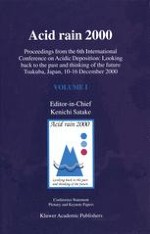2001 | OriginalPaper | Chapter
Effects of Acid Deposition on Urushi Lacquer in East Asia
Authors : Y. Tsujino, Y. Satoh, N. Kuramoto, Y. Maeda
Published in: Acid rain 2000
Publisher: Springer Netherlands
Included in: Professional Book Archive
Activate our intelligent search to find suitable subject content or patents.
Select sections of text to find matching patents with Artificial Intelligence. powered by
Select sections of text to find additional relevant content using AI-assisted search. powered by
Urushi (Japanese lacquer) plates were exposed to indoor air in 7 cities in East Asia from summer 1995 through winter 1997. The plates, collected every 3 months, were optically observed by using a gloss meter, a digital microscope and a microscopic infrared spectrophotometer for evaluation of seasonal impact by acidic air pollutants. The gloss losses were high on the urushi surface in autumn, when fog frequently appeared. Numerous fine spots were observed in 0.2–0.3 mm in diameter on the surfaces of the plates exposed at Chongqing, China, Taejon, Korea and Nara, Japan, where dense fog occurred. The spots were dark and opaque at Chongqing, where heavy air pollution was observed. A dark and opaque core was observed in each semitransparent spot at Taejon and Nara, while no spots were observed at Kyoto and Ishikawa, where fog often appeared but air pollution was at a low level. Carbonyl group, identified by microscopic infrared spectrometry, was found in the spots on the urushi surfaces. The carbonyl group may be formed by oxidation of a side-chain in urushiol (a major component of urushi sap, alkyl phenol). Urushi lacquer may be damaged by high concentration of sulfate anion, included in acid fog.
